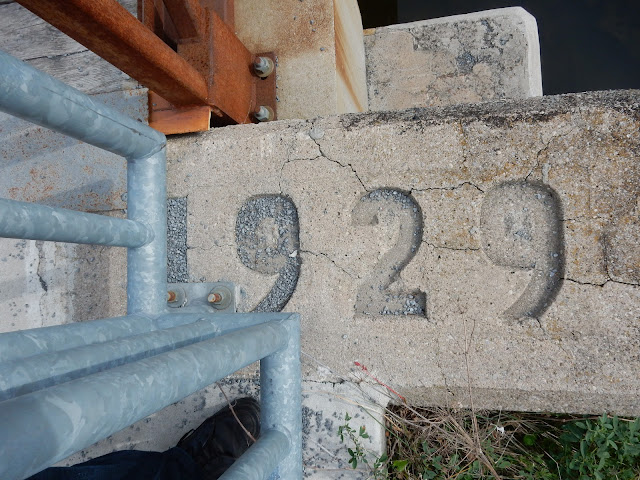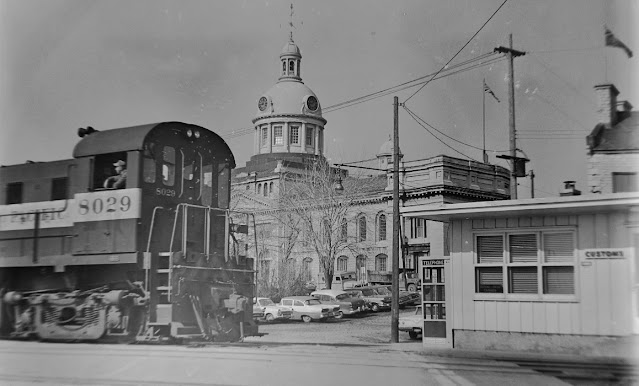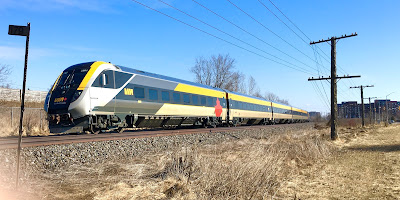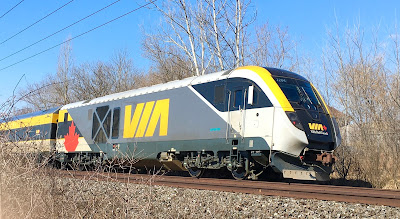In the first post in this five-post series, we traced the genesis of the Kingston & Pembroke Railway, locally referred to as 'the Kick & Push'. In this post, the K&P becomes part of CP, passenger then freight service ends, and CP leaves downtown. (Top photo - CPR 417 backs into the Ontario Street passenger station in June, 1957. Queen's University Archives, George Lilley Fonds, V25.5-38-29-1 to 34).
CANADIAN PACIFIC TAKES OVER
As of January 1, 1913 the Kingston & Pembroke (K&P) was no longer a separate legal entity (above - one of a number of Kingston Whig-Standard, Kingston Daily News and Kingston Daily Standard clippings in this series). The line officially became part of the CP system. CP owned $995,450 of the 1st preferred stock, $134,900 of the 2nd preferred stock, $1,968,000 of the common stock and $1,075,000 of the 1st mortgage bonds. CP had leased the K&P for 999 years. The K&P was subsequently to be officially referred to as CP’s Kingston Subdivision.
The August 13, 1913 directors' and shareholders' meeting was the last held in Kingston before the head office transferred to Montreal. Years later, annual shareholders’ meetings of paper companies were still being advertised in newspapers, with 2011’s meetings held in Suite 920 of Calgary’s Gulf Canada Square. At 20-minute intervals, meetings were held for the K&P, Manitoba & North Western Railway, Montreal and Atlantic Railway, Lake Erie & Northern Railway, as ordered by CP’s Chairman of the Board.
CP rebuilt almost all of the K&P’s stone culverts between 1925 and 1935, stamping the date in concrete outward on the uppermost surface. Near Sydenham Road just north of Kingston, the culvert is stamped “1927”. On the Urban K&P Trail north of Binnington Court, this culvert near Highway 401 is still visibly stamped "1929":
Much of the freight traffic generated no wealth for Kingston or even the shareholders. The line could not fully develop Kingston’s hinterland, largely because its rail corridor could not sustain much economic development nor even livelihoods. But the line was popular in later years with summer vacationers heading to Sharbot Lake and deer hunters boarding at Sharbot Lake to head to hunting camps farther north. Cream was sent to Perth Creameries from Flower Station. Storeowners in Verona waited for wares sent north from Kingston. Pulpwood was loaded into boxcars. Shoppers could take the train into Kingston on market days, arriving mere steps away from the bustling market stalls. Family members made day trips to visit relatives who still lived in the country, and vice versa, to see how new inhabitants of the city were faring in Kingston.
The train to Sharbot Lake would depart the station at 8:38 a.m., with the returning run arriving in Kingston at 7:45 p.m. The train from Renfrew arrived at 5:15 p.m., leaving the next morning at 10:30 a.m. The final Kingston to Renfrew day mixed trains, still designated 612/613 operated on June 17-18, 1957.
At the appointed time, engineer Glen White opened the throttle of D4 485 and departed with the “freight” car carrying Less-Than-Carload, mail and only a few passengers in the coach seats for Sharbot Lake. The night train still carried freight and passengers but no mail. The conductor worked from a makeshift desk at the end of the coach: overseeing two off at Glenvale plus the mail, one off at Harrowsmith, only mail taken aboard at Hartington and Verona, one off at Godfrey as the train headed north into the Shield country. So did cars on Highway 38, a growing presence on the paralleling road diminishing the importance of CP’s passenger service. The final mixed trains into Kingston were listed in the April 1959 timetable. The final Kingston-Renfrew freight train operated on December 29, 1961.
CP had no mainline connection at Kingston, unlike CN, so cars for online or Kingston customers had to be brought from Smiths Falls via Tichborne. CP freight trains to Kingston operated on an “as required” basis. CP's freight business in Kingston receded with time and with the advent of highway transport. With the closing of its freight shed across from City Hall, express and piggyback trailers were handled at a site on Place d’Armes. On May 18, 1965 CP 8029 and crew wait along the waterfront at the foot of Brock Street, at the Wolfe Island ferry dock (Queen's University Archives, Whig-Standard Fonds, V142.2-118):
CP RELOCATES AWAY FROM DOWNTOWN
With Canada’s Centennial year approaching, the City of Kingston was looking for a fitting way to memorialize important events which had taken place on the CP waterfront station site. These celebrations sought to encompass the life of the chief architect of Confederation, Sir John A. Macdonald. To do so, CP would have to vacate their property and relocate remaining operations elsewhere in the city. This February 21, 1966 view from the foot of Brock Street dock shows CP script and Soo Line boxcars near the freight station (above - Queen's University Archives, Kingston Whig-Standard Fonds, V142-3-69). Visible at left is CLC, the CP freight station and platform sheds, Prince George Hotel and City Hall just visible at right.
The City of Kingston’s Proposal for 1967 Centenary of Confederation suggested among other things, the Provincial Government authorize an agreement between CP and the city, to acquire CP land in front of City Hall and relocate CP’s facilities in the Industrial Park area. The result would be a better planned use of the downtown waterfront, incorporating a gathering place, fountain and preserving the K&P station. Each of the three partners’ shares would be approximately $150,000. The Vice-President of CP’s Eastern Region would recommend to his Board the relocation of the freight shed, tracks and office to the intersection of Highway 401 and Division Street. Cost of removal would be $265,000 exclusive of land, replacement of buildings $94,400, grading $59,600, paving $38,610 and actual removal of existing track $3,450. CPR 1095, built at CLC, was moved into position in front of the K&P station, photographed on July 5, 1966 (Below - Queen's University Archives, Kingston Whig-Standard Fonds, V142.3-182):
Land exchanged would be 2.2 acres of CP land for 48 acres of city land at $1,200 per acre. One track would be maintained at the water’s edge to service the locomotive plant and shipyards. This line was not to be used for the parking of freight cars, one of the chief objections to the present freight yard. The track could be concealed so as not to detract from the general appearance of the park. Included was restoration of the waterfront façade of City Hall. The city negotiated with CP to acquire all their land within city limits. Their station would become the Chamber of Commerce office. The piggyback ramp and yard trackage near Ontario Street and Place d’Armes, and the roundhouse property at North Street were also part of the negotiations. Read more about CP's move out of downtown in Kingston in 1966. In the interim, CP handled express out of its Place d'Armes trackage, with boxcars and a baggage car seemingly housing express shipments for delivery on July 5, 1966. (Below - Queen's University Archives, Kingston Whig-Standard Fonds, V142.3-194) Imperial Oil bulk fuel tanks are visible in middle background:
CP would build a steel express warehouse on Dalton Avenue, close to Superior Propane and Division Street, as well as an unloading ramp and team track area. A major drawback of this site was due to its remote location – a constant vulnerability to theft. Boxcars brought express shipments to the warehouse and lumber to the ramp.
With CN’s 1975 mainline curve realignment between Division and Montreal Streets, a CN-CP interchange connection was laid just west of Division Street in November, 1973: CN’s mileage 174.04 of its Kingston Subdivision; Mi. 100.78 of CP’s Kingston Subdivision. CP trains into Kingston would pull down CP’s dead-ended Kingston Subdivision in the shadows of the Division Street overpass, reversing into the two-track interchange yard CN reached from its west end. Here, CP could hand off cars to CN, and in the late 1970’s and early 1980’s, a short drive down to the end of diminutive Rigney Street usually revealed a small but colourful assortment of boxcars or gondola cars.
CP could still switch its Superior Propane and CP Express spurs north of the interchange and use its runaround track south of Dalton Avenue to marshal its train for the trip back to Smiths Falls. CP had several rail-served industries. Beginning in 1953, with customers Texaco and McColl-Frontenac Oil, CP served the Sydenham Road bulk oil tank farm at Knight’s Siding just south of Highway 401 before pipeline delivery was instituted. An Ontario Hydro transformer station in Murvale, eight miles to the north also had a CP spur.
Cars of coal for Anglin’s (in 1976) and refrigerator cars of insulated cars of produce for Quattrocchi’s (in 1979) were still delivered, but they were switched by CN. This was part of an agreement reached at the time of CN’s realignment, as CN continued to serve CP’s downtown customers via a switch connection. The connection was constructed south of Montreal and Rideau Streets where both railways’ tracks ran side-by-side. CN had to rehabilitate some weedy, swampy trackage, the maintenance of which CP had deferred. By this time, CN’s trackage ended at North Street. For a time in the mid-1980’s CN also switched Superior Propane, formerly switched by CP.
THE END
CP’s Kingston Subdivision was abandoned in segments: Calabogie to Snow Road - 27.9 miles in January 1962; Sharbot Lake to Tichborne - 8.5 miles in February 1964; Snow Road to Sharbot Lake - 14.5 miles in September 1966; Calabogie to Renfrew - 14.4 miles in February 1977; Tichborne to Kingston - 35 miles after May 9, 1986. Most abandoned trackage was removed one to five years after abandonment.
The last passengers arriving on CP rails in Kingston may have been aboard the May 4, 1974 Bytown Railway Society excursion aboard Budd Dayliner 9072. The passengers disembarked at the CP Express property and toured Kingston aboard a Kingston Transit System bus before re-boarding.
CP’s station agency at Kingston was terminated on February 24, 1976. The agent was replaced by a mobile Customer Service Centre supervisor based in Kingston.
On July 16, 1984 Sperry Rail Service detector car 129 attempted to test the rails on the Kingston Subdivision. Testing was abandoned due to heavy build-up of rust from disuse.
CP helped moved Canadian Forces vehicles on flat cars from CFB Kingston to major military exercises in Alberta in 1985. The last train on the subdivision was a rail pick-up train in January, 1987. On August 5, 1987 contractors removed the last vestiges of level crossings along the abandoned CP trackage near City Hall, Rideau Street, Montreal Street, Railway Street between Montreal and Patrick Streets, and Dalton Avenue. City of Kingston’s George Beltrami noted that this was the last stage of removal of CP trackage in the city which had gradually taken place in the previous six years.
In the third post in this series K&P/CP facilities in Kingston, facilitated by your humble factotum in a facile figuring.
Running extra...
The haul from last Saturday's Napanee Train Sale - 110 dollars of fun. Well-attended, and it was nice to chat with Associated Railroaders of Kingston members Andrew, Michael, Len, Marc, Tom, Len and Grant, plus my brother and sister-in-law, also Allen Hansen and Steve, who worked at Lloyd Shales and Peter Macdonald Hobby Supplies at least 35 years ago. When in Napanee, stop by Chuck's Roadhouse for the $9 burger and fries (to go in our case, as Belleville was the next stop). Our grandsons were pleased with the vintage Plasticville garage and Lima intermodal crane!
Talking to Steve about growing up on Rideau Street, he asked if I had any 'wine flies' on my Hanley Spur layout. Known by many such names, winos were known to inhabit the boathouses along the Inner Harbour and indeed some unhoused folks do inhabit my layout!















































